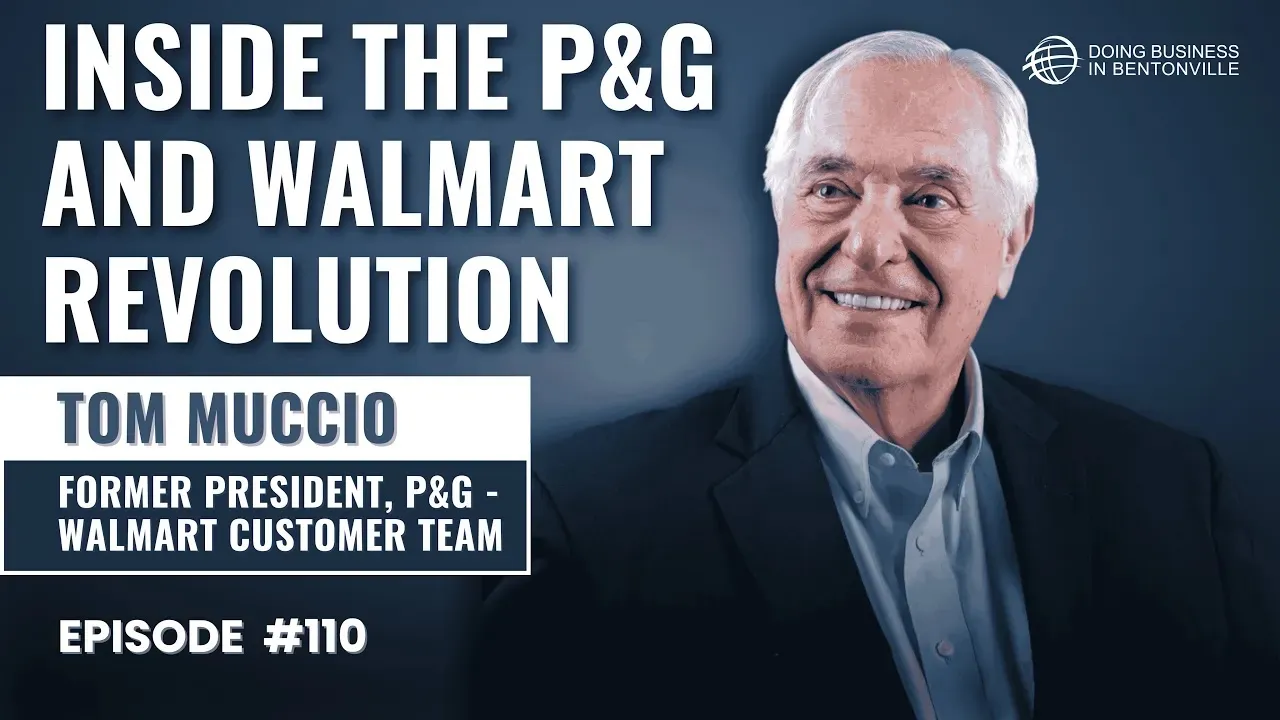Join us as we explore the transformative partnership between corporate giants Walmart and Procter & Gamble (P&G) in this captivating episode. Guided by the experiences of Tom Muccio, we delve into the essence of “collaborative disruption.”
This principle has shaped the way these two companies have learned to work together, impacting retail and supply chain dynamics significantly.
Listeners will uncover how trust and open communication can catalyze success, as Tom shares with host Andy Wilson real-life anecdotes that illustrate the hurdles overcome through mutual respect. The conversation covers significant learning moments, emphasizing the importance of putting teams together to address challenges cohesively.
Moreover, we discuss how putting the customer first—both at Walmart and P&G—led to innovative practices that transformed their operations. Insights into the flowcharting process reveal how visibility into business processes allowed for improved efficiencies and quick wins.
As we face ever-evolving market challenges, the lessons gleaned from this partnership shine a light on the importance of adaptive strategies that ensure continuous collaboration and growth.
Let's lean in as we dissect the principles of collaborative disruption and inspire listeners to re-energize their business philosophies. Don't forget to subscribe, share, and leave a review!
More About this Episode
The Real Impact of Collaborative Disruption: Lessons from P&G and Walmart's Groundbreaking Partnership
In today's rapidly evolving retail landscape, where consumer behavior, supply chain dynamics, and technological advancements are constantly shifting, the importance of authentic, strategic collaboration between companies cannot be overstated. Few examples illustrate the transformative potential of such collaboration better than the historic relationship between Procter & Gamble (P&G) and Walmart.
What began in the mid-1990s as a strategic experiment evolved into a fundamental reshaping of the supplier-retailer dynamic. This partnership changed the way retail and manufacturing work together and established a model for trust, innovation, and growth.
In a recent discussion with Tom Muccio, the former President of Walmart Customer Teams at P&G and a central figure in building this partnership, we explored the second phase of that journey. While the first phase focused on aligning objectives and establishing a new business model, the next chapter was about execution, integration, and scaling.
The lessons learned from this experience remain critically relevant for today’s business leaders.
From Co-Location to Co-Creation: Building True Integration
Relocating a dedicated P&G team to Bentonville, Arkansas, Walmart’s headquarters, marked a pivotal moment in the evolution of the partnership. P&G was the first supplier to make this move, which allowed for greater proximity, deeper engagement, and faster decision-making. Today, more than 2,000 suppliers have followed suit, but at the time, it was groundbreaking.
The decision enabled the formation of a “mirror team” composed of leaders from both organizations and across key functions. This group operated as a joint board of directors for the relationship. They engaged in deep process mapping to identify redundancies and inefficiencies and to create integrated solutions. For example, they discovered both companies were duplicating processes that could be streamlined, saving time and resources.
Cross-functional alignment is foundational. When both sides understand the entire system, they can collaborate effectively and identify solutions that neither could achieve independently.
Building Empathy Through Shared Learning
One of the most impactful strategies P&G implemented was requiring its team members to spend a week working in Walmart stores. This provided firsthand exposure to Walmart’s retail environment and customer experience, which helped eliminate assumptions and misunderstandings.
In return, Walmart associates attended P&G’s branding and innovation seminars to better understand how product development and brand strategy functioned. This mutual exchange of knowledge fostered respect and insight, breaking down traditional barriers between supplier and retailer.
Revolutionizing Product Launches Through Agility
A major outcome of the P&G-Walmart collaboration was the transformation of the product launch process. Historically, launching a new product at P&G could take 16 weeks or longer. By the time the product reached stores and advertising began, valuable momentum was lost.
Walmart proposed a solution. Confident in P&G’s product quality and consumer appeal, Walmart offered to bypass the lengthy approval process. They agreed to warehouse new items and distribute them to stores within days, provided P&G could meet inventory demands.
This acceleration brought about a new challenge: how to educate consumers before national advertising began. The solution became known as shopper marketing, which focused on educating and influencing consumers in-store at the moment of purchase. As a result, P&G began launching advertising campaigns as early as the fifth week of a product's release. Speed requires early collaboration. Agile execution is only possible when both partners are integrated from the outset.
Earning Trust Through Consistent Action
Throughout our discussion, Muccio emphasized the importance of trust, not as a concept but as a measurable outcome of consistent, ethical behavior. Trust was built in the small, often difficult decisions that reinforced the integrity of the relationship.
When P&G made a pricing error or needed to honor pre-arranged promotional pricing despite a price increase, they chose to do the right thing rather than the convenient thing. Similarly, Walmart took full responsibility for large inventory commitments, even when sales underperformed expectations. Trust is earned through principled decision-making. It becomes the foundation upon which long-term collaboration is built.
Supply Chain Innovation and Vendor-Managed Inventory
Another breakthrough came with the implementation of vendor-managed inventory (VMI). Traditionally, retailers placed orders, which were then relayed up the supply chain. P&G proposed a more direct approach: using Walmart’s real-time sales data to manage inventory levels themselves.
Although this approach was initially met with skepticism, the results were undeniable. Manufacturing efficiency improved, supplier forecasting became more accurate, and product availability increased. P&G took ownership of supply chain execution using Walmart’s rules and data, creating a more responsive and efficient system.
Data Sharing and the Development of RetailLink
A critical enabler of collaboration was the development of RetailLink, Walmart’s internal data system, which was extended to suppliers. While originally intended for internal business management, RetailLink became a vital tool for supplier engagement. It provided real-time data that allowed suppliers to make faster, smarter decisions.
P&G used RetailLink to identify missed opportunities, correct issues, and innovate based on consumer behavior insights. This transparency built even greater trust between the two organizations.
Expanding the Model to Other Retailers
As the Walmart-P&G partnership grew, other retailers began to take notice. Executives from Target, Costco, and others wanted similar collaboration. However, Muccio emphasized that this was not a one-sided solution. Collaboration required both parties to invest resources and commit to shared innovation.
P&G offered similar support to other retailers, but only if they were willing to match the commitment. Importantly, P&G established strict internal firewalls to ensure proprietary knowledge remained confidential across customer teams.
The results of this collaboration were profound. In 15 years, the P&G-Walmart relationship grew from $350 million to $8 billion in annual business. Walmart’s profitability in those categories improved by 20 percentage points, and P&G gained market share through faster innovation and better customer alignment.
The Enduring Power of Collaborative Disruption
As we look ahead, it is clear that the principles behind this partnership are as relevant today as they were 20 years ago. While COVID-19 and remote work temporarily disrupted collaboration across many organizations, there is now a renewed opportunity to rebuild.
Collaboration requires support from senior leadership, cross-functional alignment, transparency, and a shared commitment to doing what is right. Disruption, in and of itself, is not enough. Without collaboration, it leads to chaos rather than progress.
Muccio’s book, Collaborative Disruption, outlines these principles in depth and continues to influence leaders across the retail and manufacturing industries. As Walmart CEO Doug McMillon noted in naming the book one of his top reads of the year, the lessons are timeless.










